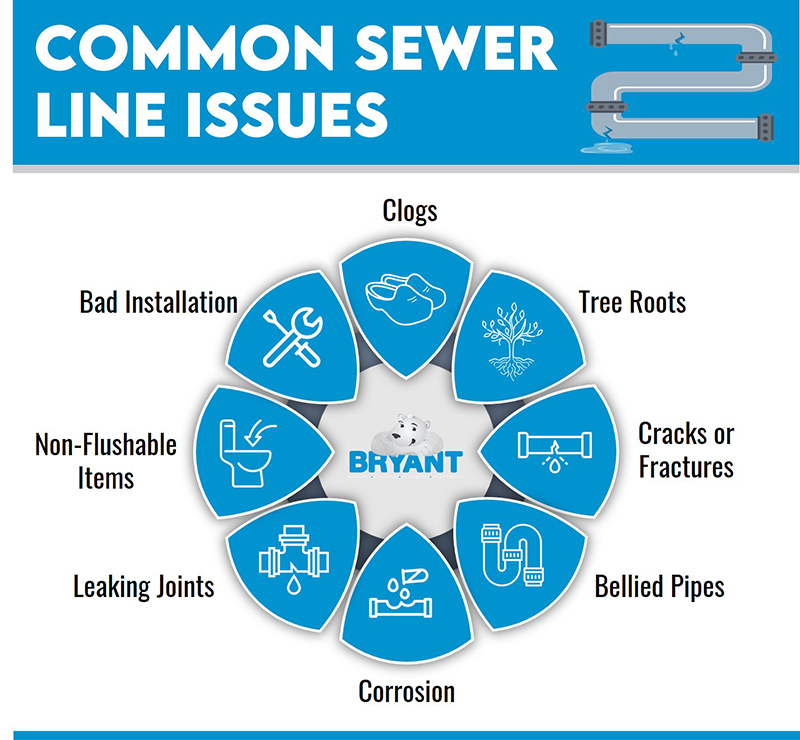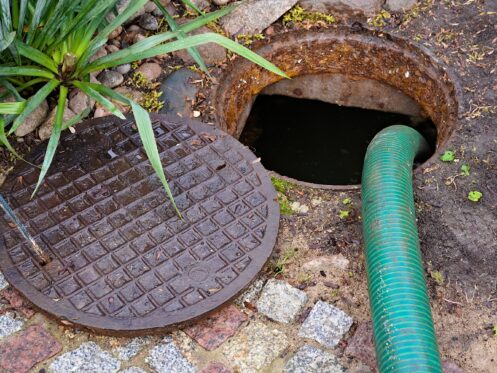Your home’s sewer system performs a major role in getting rid of sewage and wastewater and keeping your home sanitary. However, like most infrastructure, sewer lines may develop issues over time. Understanding these common problems can help you spot them and tackle them as early as possible. Our team at Bryant Heating, Cooling, Plumbing & Electric has compiled eight of the most common types of sewer line issues so that you know what to look for when you think something may be amiss.
1. Clogs
Clogs are one of the most prevalent issues when it comes to sewer line issues. They develop when grease, debris, or other substances accumulate in the sewer line. Some of these substances may be nondegradable wipes, sanitary products, and other objects that aren’t supposed to go down a drain. A clog obstructs the normal flow of wastewater, which means that water can start to back up, or you may have slow drains. You may notice a gurgling sound or unpleasant odors as well. These are all symptoms of a clog in the sewer line for your home.
2. Tree Roots
Signs of tree root infiltration include slow drains, gurgling noises, and recurring clogs. If left unchecked, roots can cause complete obstructions and even pipe collapse. To prevent tree root intrusion, you need to avoid planting trees and bushes near your home’s sewer lines. The EPA recommends maintaining a distance of at least 10 feet. Opting for slow-growing plants with less aggressive root systems can also help. Additionally, scheduling regular plumbing inspections to detect and address root intrusion early is crucial. A plumber can use camera inspections to identify issues and recommend solutions like root removal or chemical inhibitors.

3. Cracks or Fractures
Cracks and fractures in your home’s sewer line may result from shifting soil, freezing and thawing, or other environmental factors. These openings in a sewer line can allow soil to enter the pipes, causing potential blockages and further damage. You may notice water damage around your property, unpleasant odors, and even slow drains. Regular inspections and maintenance by one of our plumbers can help detect cracks and fractures early, so you don’t have to deal with costly repairs and replacements.
4. Bellied Pipes
Bellied pipes occur when a sewer line sinks due to shifting or unstable soil conditions. The sewer line may not crack, but sagging creates a low spot where waste and debris accumulate. This accumulation leads to slow drainage and blockages. You may notice clogs that occur often, as well as backups in the toilets and sinks in your home. You may also notice water pooling around your property or unusually lush spots of grass or plants, indicating a bellied pipe.
5. Corrosion
If the sewer line in your home is fairly old and made of metal, corrosion may be an issue. Metal pipes, typically installed before the 1970s, have a lifespan of 50 to 70 years. Over time, they react with water and soil, causing rust and deterioration. This can lead to weakened pipes, leaks, or even a complete collapse.
Modern materials like PVC and HDPE are now used for sewer lines due to their superior durability and resistance to corrosion. These materials can last over 100 years, significantly reducing the need for frequent repairs or replacements. Replacing old metal pipes with these modern alternatives ensures a longer-lasting, more reliable sewer system for your home.
6. Leaking Joints
Leaking joints occur when the seals between pipe sections deteriorate due to age, ground movement, and temperature changes. These seals, often made of rubber or other flexible materials, ensure that sections of the sewer line remain watertight. As seals degrade, water can leak from the joints, creating damp soil that attracts tree roots, which can infiltrate the pipes and cause further damage.
Different types of joints include rubber ring joints, solvent-weld joints, and mechanical joints. Each type has vulnerabilities; for instance, rubber ring joints can lose elasticity over time, while solvent-weld joints may degrade due to chemical reactions. When a plumber addresses faulty joints, they typically inspect the sewer line using a camera to locate the leak. Depending on the severity, they may replace the seals or recommend replacing entire sections of the pipe to ensure a long-term fix.
7. Non-Flushable Items
Flushing non-flushable items leads to significant sewer line issues. Items like paper towels, feminine hygiene products, and toys can cause severe blockages in your home’s plumbing system. Unlike toilet paper, these objects do not dissolve in water, leading to accumulation and stubborn clogs. When these items enter the sewer system, they can halt or slow the wastewater flow, potentially damaging pipes and causing backups. You might notice toilets needing a plunger more often or signs of sewage backing up in bathrooms and sinks.
If using a plunger does not clear the clog quickly, do not keep plunging, as this can push objects deeper into your plumbing, causing a bigger problem. In such cases, the situation requires immediate professional attention to prevent further damage to the sewer line.
Educate all household members and visitors about what should and should not go down your home’s drains to prevent sewer line issues with non-flushable items. Posting reminders in the bathrooms and kitchen is a good idea, especially if you frequently have guests. Childproof toilet locks can help prevent young children from flushing toys and other items. Proactively managing what gets flushed can save you from costly repairs and keep your plumbing system running smoothly.
8. Bad Installation
Poor installation of sewer lines has the potential to lead to many problems with a sewer line. These issues include leaks, blockages, and premature pipe failure. When plumbers don’t follow appropriate installation techniques, they can leave pipes improperly connected or without enough support. These types of mistakes result in issues like misaligned joints, insufficient slopes for gravity drainage, and weak spots that may cause leaks.
Indicators of badly installed sewer lines include slow drains, damp spots on your lawn, and bad odors emitting from your drains or outside of your home. If you suspect that your plumbing issues stem from poor installation, our team can conduct a thorough assessment of your sewer line. Correcting improper installation is crucial to avoid problems and maintain the optimal performance of your drainage system.
Contact the Pros
At Bryant Heating, Cooling, Plumbing & Electric, we have been serving the residents of Louisville, KY since 1940. We are expert plumbers who offer sewer and drain services. We also install, maintain, and repair heating and cooling systems.
Contact Bryant Heating, Cooling, Plumbing & Electric today to schedule an appointment with one of our knowledgeable team members!



